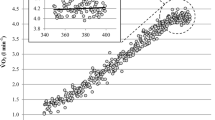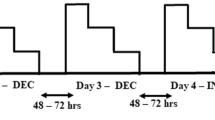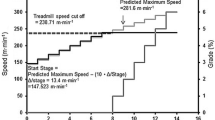Abstract
Introduction
A plateau in oxygen consumption (V˙O2 plateau) remains the definitive criteria for establishing that maximal oxygen consumption (V˙O2max) was achieved during maximal exercise despite its inconsistent presence. Anaerobic capacity may assist in achieving a V˙O2 plateau.
Purposes
To determine if a correlation exists between maximal accumulated oxygen deficit (MAOD) and magnitude of V˙O2 plateau during treadmill exercise.
Methods
Participants completed submaximal, maximal, and supramaximal exercise treadmill tests on separate occasions. MAOD was determined during the supramaximal test by calculating the difference between oxygen consumption (V˙O2) and predicted V˙O2 based on extrapolation of submaximal data. V˙O2 plateau was determined as a < 50 ml change in V˙O2 over the last 60 s of exercise.
Results
Ten of seventeen participants showed a plateau in V˙O2. Oxygen deficit was not different between the plateau and non-plateau groups (44.2 ± 10.8 vs. 44.8 ± 8.5 ml·kg−1, p = 0.906). Oxygen deficit was not correlated with change in V˙O2 (r = − 0.087, p = 0.739). Aerobic training hours·week−1 were higher in the plateau group than non-plateau (4.8 ± 1.5 vs. 1.7 ± 2.1, p = 0.003) and correlated with change in V˙O2 (r = − 0.418, p = 0.048).
Conclusions
In treadmill running, there is not a significant correlation between V˙O2 plateau and MAOD as has been seen in cycling.

Similar content being viewed by others
References
Hill AV, Lupton H (1922) The oxygen consumption during running. J Physiol 56:xxxii-xxxiii
Beltrami FG, Wong del P, Noakes TD (2014) High prevalence of false-positive plateau phenomena during V˙O2max testing in adolescents. J Sci Med Sport 17(5):526–530
Poole DC, Wilkerson DP, Jones AM (2008) Validity of criteria for establishing maximal O2 uptake during ramp exercise tests. Eur J Appl Physiol 102(4):403–410
Carter H, Pringle JS, Barstow TJ et al (2006) Oxygen uptake kinetics during supra V˙O2max treadmill running in humans. Int J Sports Med 27(2):149–157
Wagner PD (2000) New ideas on limitations to V˙O2max. Exerc Sport Sci Rev 28(1):10–14
Gordon D, Hopkins S, King C et al (2011) Incidence of the plateau at V˙O2max is dependent on the anaerobic capacity. Int J Sports Med 32(1):1–6
Morales-Alamo D, Losa-Reyna J, Torres-Peralta R et al (2015) What limits performance during whole-body incremental exercise to exhaustion in humans? J Physiol 593(20):4631–4648
Gordon D, Mehter M, Gernigon M et al (2012) The effects of exercise modality on the incidence of plateau at V˙O2max. Clin Physiol Funct Imaging 32(5):394–399
Russell A, Le Rossignol P, Kai Lo S (2000) The precision of estimating the total energy demand: implications for the determination of the accumulated oxygen deficit. J Exerc Physiol 3(2):55–63
Hawkins MN, Raven PB, Snell PG et al (2007) Maximal oxygen uptake as a parametric measure of cardiorespiratory capacity. Med Sci Sports Exerc 39(1):103–107
Scheadler CM, Devor ST (2015) V˙O2max measured with a self-selected work rate protocol on an automated treadmill. Med Sci Sports Exerc 47(10):2158–2165
Robergs RA, Dwyer D, Astorino T (2010) Recommendations for improved data processing from expired gas analysis indirect calorimetry. Sports Med 40(2):95–111
Medbo JI, Mohn AC, Tabata I et al (1988) Anaerobic capacity determined by maximal accumulated O2 deficit. J Appl Physiol 64(1):50–60
Myers J, Walsh D, Sullivan M et al (1990) Effect of sampling on variability and plateau in oxygen uptake. J Appl Physiol 68(1):404–410
Astorino TA, Willey J, Kinnahan J et al (2005) Elucidating determinants of the plateau in oxygen consumption at V˙O2max. Br J Sports Med 39(9):655–660 (Discussion 660)
Millet G (2009) Physiological differences between cycling and running. Rev Med Suisse 5(212):1564–1567
Sousa A, Figueiredo P, Zamparo P et al (2015) Exercise modality effect on bioenergetical performance at V˙O2max intensity. Med Sci Sports Exerc 47(8):1705–1713
Zoladz JA, Grassi B, Majerczak J et al (2014) Mechanisms responsible for the acceleration of pulmonary V˙O2 on-kinetics in humans after prolonged endurance training. Am J Physiol Regul Integr Comp Physiol 307(9):R1101-1114
Doherty M, Nobbs L, Noakes TD (2003) Low frequency of the “plateau phenomenon” during maximal exercise in elite British athletes. Eur J Appl Physiol 89(6):619–623
Author information
Authors and Affiliations
Corresponding author
Ethics declarations
Conflict of interest
The authors declare that they have no conflict of interest.
Ethical approval
All procedures performed in studies involving human participants were in accordance with the ethical standards of the institutional and/or national research committee and with the 1964 Helsinki declaration and its later amendments or comparable ethical standards.
Informed consent
Informed consent was obtained from all individual participants included in the study.
Rights and permissions
About this article
Cite this article
Scheadler, C.M., Hanson, N.J. V˙O2 plateau in treadmill exercise is not dependent on anaerobic capacity. Sport Sci Health 14, 415–420 (2018). https://doi.org/10.1007/s11332-018-0457-y
Received:
Accepted:
Published:
Issue Date:
DOI: https://doi.org/10.1007/s11332-018-0457-y




